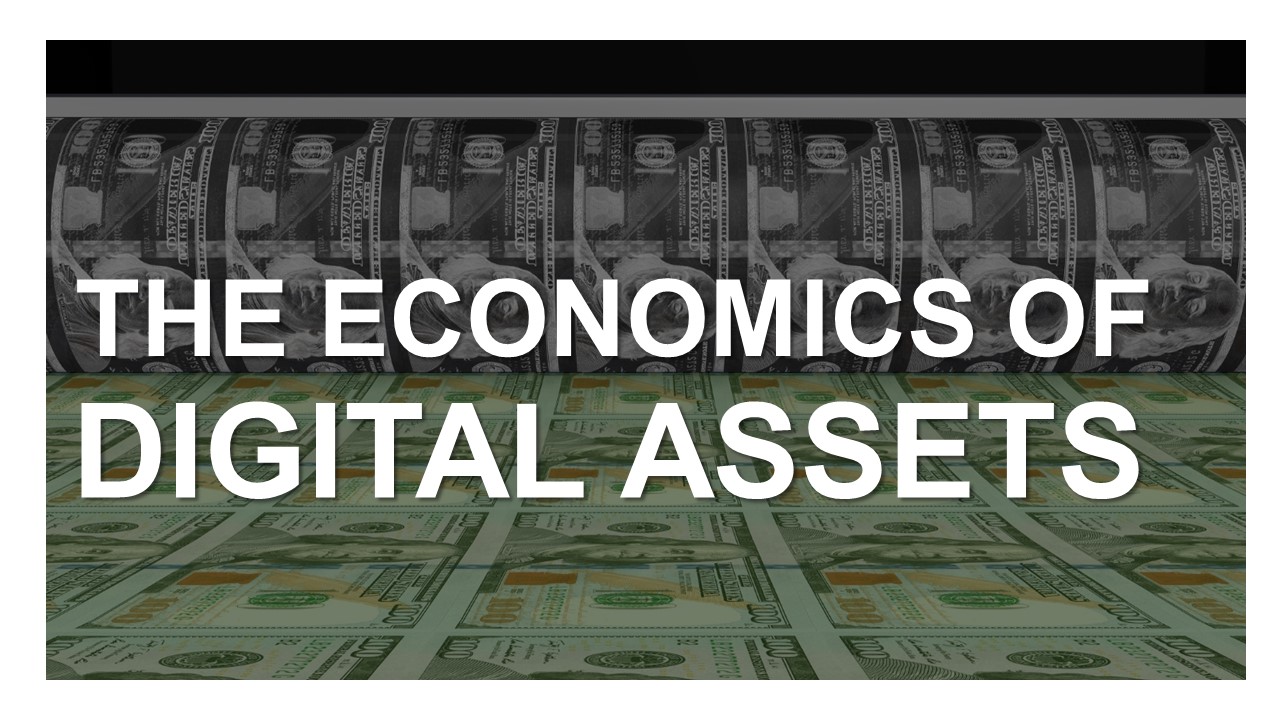
Summary
- Many fortunes were made in 2021, at least on paper, in a relatively new genre of investments known as digital assets.
- Economic value in digital assets is captured in areas such as inflation hedging, entertainment, and finance.
- Investors have many ways to participate in digital assets. A simple approach could be accomplished via a “core, satellite” strategy where 70% of the digital assets portfolio (‘the core”) consists of Bitcoin, Ethereum and interest paying stable coins. The remaining 30% for the “satellites” could include other cryptocurrencies including NFTs.
Download and/or print or continue reading.
Many fortunes were made in 2021, at least on paper, in a relatively new genre of investments known as digital assets. Bitcoin topped $69,000 this past November before finishing around $48,000. That was still a remarkable gain of 65% for the year, crushing the S&P 500’s total return of nearly 29%. A pixelated work of art from a collection known as the “CryptoPunks” sold for over $10M, and Axie Infinity, a video game with a play-to-earn platform, saw its cryptocurrency skyrocket 15,869%!
The astonishing performance of many digital assets last year was driven by a combination of easy monetary policy, rising inflation, and the global population spending a lot more time at home. Though easy to cast aside digital assets as just another “meme” trade along the lines of AMC and GameStop stocks, there’s an important economic transformation underway within this frontier asset class.
The Economics of Digital Assets
Ready or not, crypto is the new kid on the block along with its friends decentralized finance (‘Defi’), Web 3.0, and metaverse. Crypto’s peculiar terminology will one day be as ubiquitous as the vocabulary that also once struck us as strange when the Internet first burst onto the scene. When we were introduced to streaming, JPEGs, browsers, and email, it felt a tad overwhelming. Just as society adjusted to the Internet, so shall we with crypto. If you’re a twenty-something or younger, don’t laugh.
In bridging the marketplace of today with the one of the future, let’s start with the traditional corporation like Microsoft or Meta (f.k.a. Facebook). These corporations own all aspects of their innovation and the resulting profits into perpetuity. Outsiders can share in the rising tide of economic fortunes as a stockholder, an employee, or both. If an employee leaves, the corporation retains ownership of everything produced during the employee’s tenure. The employer usually has no obligation to pay former employees even if their projects haul in enormous profits well after they are gone. This is accepted as customary.
In contrast, a digital assets platform utilizing blockchain has the ability to distribute the ownership of anything from intellectual property, to real property, to art and music in a decentralized manner.
A decentralized system stores data on thousands of nodes connected to the Internet and is designed to limit the influence of a single actor. It is even possible to develop smart contracts which pays the owners royalties when their items are subsequently traded. In essence, the person or even a decentralized autonomous organization (“DAO”) consisting of thousands of individuals could own the rights to the property and profits, theoretically forever. This is widely referred to as the “creator economy” meaning the creators remain the ongoing beneficiaries of their creations.
Independent View
Receive our quarterly market outlook directly in your inbox.
Value Creation in Digital Assets
Similar to how raw materials are fashioned into products of greater value to the consumer, digital assets need to provide related utility in order to be economically relevant. Economic value is captured in areas such as inflation hedging, entertainment, and finance. Since March 2020, the correlation of Bitcoin price movements to the changes in long-term inflation expectations (10-years forward) is an astounding 0.90 or almost perfectly correlated. Investors looking for a near pure play on rising inflation can hold Bitcoin which is efficient yet highly volatilie relative to TIPS bonds.
On the entertainment front, consider the economics with sports memorabilia and collecting. It’s estimated that 90% of sports memorabilia is counterfeit. Tom Brady recently launched an NFT (Non-Fungible Token) collection that can be traded on the blockchain. Why would this have value? With NFTs, the consumer knows this item is authentic and if subsequently traded, the next owner also knows it’s authentic. No more dealing with the supposedly highly rated seller who in the end turned out to be a fraud. In finance, users from around the world can transfer money from one place to another for less than a penny in some cases versus the interchange fees via traditional money transfer methods that are relatively expensive.
The Internet, also a distributed network, enables exceptional efficiency in commerce. However, it’s not immune to large corporate centralization which can work against efficient deployment of resources in fulfilling consumer demands. An online market place allows the individual to sell what they wish and collect funds, but a centralized entity can de-platform anyone for any reason, confiscate their funds and impose restrictions that effectively ban them, in some cases, from a very profitable livelihood.
In contrast, the invention of public blockchain, also hosted on the internet, empowers individuals to conduct commerce independent of most centralized entities. The proponents of the decentralized platforms sometimes suggest a new economy is emerging, but it’s better to think of these technologies in terms of microeconomics, or evaluating how individuals allocate scarce resources. A key tenet of the decentralized platform is its characteristic of permitting the settlement of transactions between two willing parties without interference from an outside party.
Turns out these types of decentralized networks are in hyper-demand. Per Cathie Wood at Ark Investment Management, Bitcoin’s transactional volume of $13.1T exceeded Visa’s in 2021. The utility of the networks for transaction purposes validate blockchain’s technological success as well as its economic benefits.
Investing in Digital Assets – Embrace Volatility like a Venture Capitalist
The volatility of digital assets, uncertainty around regulatory actions, and the infancy of digital asset exchanges has understandably kept many institutional investors on the sidelines. Yet, digital asset management is a burgeoning business. Getting involved, however, is more complicated than simply opening a brokerage account and buying your favorite stock or mutual fund.
If you are considering investments in digital assets, you’ll need to take the mindset of a venture capitalist. Successful VCs are willing to be imaginative, take several shots on goal, and accept risks which most people consider unnerving. Just as with many VC companies, cryptocurrencies are very difficult to gauge valuation using discounted cash flows and relative value metrics like P/E which most traditional finance teams anchor to for decision-making and risk management. Yet, the VC doesn’t get obsessed by the need for this data as the goal is to find a theme, a management team, and a never before thought of application for a potentially explosive growth opportunity.
Building a Digital Assets Portfolio
According to coinmarketcap.com, there are 9,288 unique cryptocurrencies not including all of the NFTs. How can you embark upon creating a portfolio when confronted with all of these choices? One way is by utilizing a “core, satellite” investment strategy with the foundation as the broader market determined by market cap. Many professional investors in traditional finance hold an allocation to an index like the S&P 500 which serves as the “core” and select other investments, the “satellites,” in an attempt to beat the index return.
Conceptually, the same can be done with cryptocurrencies. As of today, a core crypto position could consist of a handful of options to gain exposure to 70% of the market. Nearly 60% of the total market cap is Bitcoin (41%) and Ethereum (18%). Stablecoins make-up about 10% of the market. These coins are designed to hold value constant (i.e. pegged to the dollar) with some paying interest. Examples of stablecoins include Gemini, Tether, Terra, and USDC.
What do you do with the other 30%? You don’t have to invest much beyond Bitcoin, Ethereum, and stable coins to get market exposure. If that’s all you have an appetite for, simply readjust the proportions of the 70% to fill out the 100%. This kind of portfolio would consist of 59% Bitcoin, 26% Ethereum, and 15% stable coins. Keep in mind, this portfolio will have volatility magnitudes more than a typical equity investment. If you choose to venture into lesser known cryptos, I like what Ryan Allis of HeartRithm Technologies does by sticking to coins with greater than $5B in market cap. Some crypto strategies are “market neutral” and focused on yield; currently these are available only for high net worth individuals requiring $250K to start.
In closing, cryptocurrencies and decentralized platforms offer economic benefits for many. Some of the companies in your traditional stock portfolios are on the move. Microsoft just announced the purchase of Activision Blizzard to expand its footprint in the metaverse while some companies are adding Bitcoin to their balance sheet. For the pioneering type of investor, be sure to read through “A Digital Assets Investor’s Starter Guide” on the next page that will prove helpful while you contemplate your next move.
Gain More Insights
A Digital Assets Investor’s Starter Guide
Key Considerations for Digital Assets Investors
Total Portfolio Allocation
- Limit your exposure to digital assets to 5% of your net worth. You can use a taxable account to offset loses or even a crypto IRA which simplifies the complicated details when computing cost basis.
Access Points to Buying Crypto
- You can set-up a MetaMask (Google for more info) which allows you to self-custody your assets or open an account on an exchange like Coinbase, Gemini, and Binance.
Funding Your Account on an Exchange
- Exchanges may require you to send a same-day wire to verify your account. There’s some cost for doing this, usually about $25. Once your account is established, you can link it to the bank and make ACH transfers which are cheap.
- A few banks will not let you link your exchange to their accounts due to fraud concerns. Check with your financial institution to see if they have imposed restrictions.
- Credit cards can fund these accounts, but the fees are outrageous. The exchange has its fees while credit card companies classify these transactions as ‘cash advances’ which brings additional fees plus higher interest charges than regular purchases. Do not use this option.
- If you use an exchange, you will need to comply with regulations such as providing an electronic copy of your driver’s license.
- On most exchanges, a limited number of the 9,288 cryptocurrencies are available to trade.
Loads of Risk – Buyer Beware – Seriously
- Volatility, the door swings both ways – the recent drop in the equity markets caused by fears of tighter monetary policy are amplified in crypto. Recall earlier how inflation expectations and Bitcoin prices are highly correlated. Bitcoin was up 65% in 2021 but is already down 21% (through 1/27/22) as the Fed moves into inflation fighting mode.
- Government regulations are in flux; you could incur substantial loses if new regulations are viewed unfavorably in the marketplace.
- Not every cryptocurrency follows the same decentralized model as Bitcoin or Etheruem; during the last ‘crypto-winter’ bear market, decentralized currencies like Bitcoin survived while others relying on centralization failed.
- Theft by bad actors – The nature of crypto transactions is such that if someone hacks into your account and moves your crypto, it is difficult and perhaps impossible to recover stolen funds. Two factor authentication is a must and be sure that if you use your phone for viewing your account to add a PIN number to your cell phone account to avoid the risk of “SIM-swapping.” I’ll let you look that up to be sufficiently freaked-out as to why you should have this in place.
- Your crypto could go to zero – Many cryptos have died a horrible death. Celebs Kim Kardashian, Floyd Mayweather, and Quentin Tarantino are currently facing lawsuits from investors angered over what was allegedly a pump-n-dump crypto scheme.
Additional Resources
- What’s an NFT? See the Research Review in this publication for more information.
- Bankless research: https://banklesshq.com/ for tips, strategies, ideas, and podcasts. Messari is another firm worth checking into: messari.io on the Internet. FIC has no affiliation with either organization and receives no compensation.
- DeFi and the Future of Finance 1st Edition by Campbell R. Harvey (Author), Ashwin Ramachandran (Author), Joey Santoro (Author), Vitalik Buterin (Preface). Can be ordered on Amazon.
- Bitcoin, other forms of cryptrocurrency are here for the long haul, Michael Francis, JSOnline, October 17, 2021.

The NFT Handbook
How to Create, Sell and Buy Non-Fungible Tokens
Authored by Matt Fortnow and QuHarrison Terry
Summary by Edward McIlveen, CFA
It’s hard for many to fathom, but the picture above, “CryptoPunk #4156,” sold for $10.25M in December 2021. How can a pixelated image fetch such a high price tag at auction? Matt Fortnow and QuHarrison Terry dive into emerging world of Non-Fungible Tokens (NFTs) in The NFT Handbook to explain what they are and how they can be part of our everyday lives.
What are NFTs?
NFTs are unique items verified and secured by a blockchain, the same type of technology as utilized in cryptocurrency. An NFT provides authenticity of origin, ownership, uniqueness, and hypothetically, permanence for any specific item. Fortnow and Terry argue NFTs will be the place where that passion for collectibles and luxury goes to next as the metaverse becomes commonplace. Each NFT is technically its own cryptocurrency but the material, say an image, that the owner has access to is not on the blockchain. In other words, the image may be stored on an AWS (Amazon Web Services) or Google server and the owner has the keys to access and sell the content as desired via what is known as a “smart contract.”
Takeaways and Rapidly Emerging Trends
Nike and Adidas are signing deals to get NFTs incorporated into their marketing strategies. You can view some of the latest from Adidas here: https://www.adidas.com/into_the_metaverse. Virtual luxury wearables are also available from Gucci and Burberry and high end auction houses are embracing the trends including Christie’s and Sotheby’s who expressed interest in the aforementioned CryptoPunks.
What Creates Value for NFTs?
The authors maintain NFTs create value given their relevance to the holder in terms of meaning, utility, investment potential, prestige, and collecting purposes.
The blockchain technology enables the aspects of assuring authenticity and proof of provenance. Currently, estimates are that 50% of all collectible art is fake, 90% of sports memorabilia is counterfeit, and up to 80% of antiques sold online are likely looted or replicas. NFTs help eliminate frauds, forgeries and supply manipulation.
How Can Someone Get Involved?
Anyone can buy and sell NFTs on OpenSea with cryptocurrency like Ethereum. Other exchanges include Rarible, Nifty Gateway, SuperRare, and many others. You will need a MetaMask to interact with these exchanges though centralized exchanges like Coinbase are moving quickly to create NFT marketplaces. MetaMask, by way of introduction, is a web browser extension that allows you to manage your Ethereum private keys via your web browser serving as a wallet for you to self-custody.
The book explains in detail how to create, buy, and sell NFTs. So if you have some art, a picture, music, and the like, you could sell these as NFTs. Who knows? You might just be the next artist to get discovered thanks to technological innovation.
The information/summary/prices/quotes/statistics contained herein have been obtained from sources believed reliable but are not necessarily complete and cannot be guaranteed. Past performance results are not necessarily indicative of future results. Francis Investment Counsel does not provide tax or legal advice.




